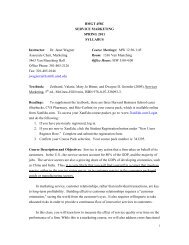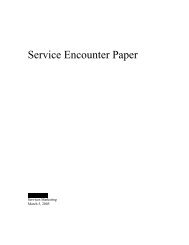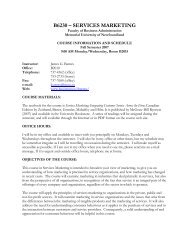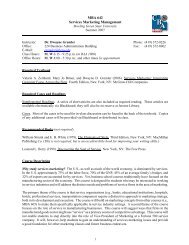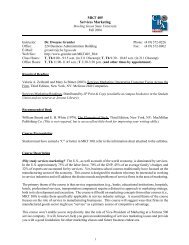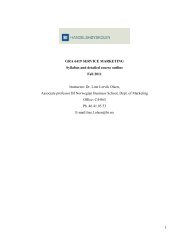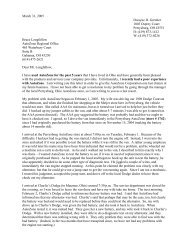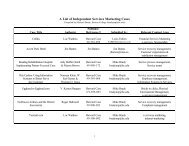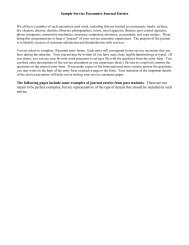Rapport-Building Behaviors Used by Retail Employees - Gremler.net
Rapport-Building Behaviors Used by Retail Employees - Gremler.net
Rapport-Building Behaviors Used by Retail Employees - Gremler.net
You also want an ePaper? Increase the reach of your titles
YUMPU automatically turns print PDFs into web optimized ePapers that Google loves.
D.D. <strong>Gremler</strong>, K.P. Gwinner / Journal of <strong>Retail</strong>ing 84 (3, 2008) 308–324 323Churchill, Gilbert A., Robert H. Collins and William A. Strang (Fall 1975),“Should <strong>Retail</strong> Salespersons be Similar to Their Customers?” Journal of<strong>Retail</strong>ing, 51 29–44.Clark, Colin, Paul Drew and Pinch Trevor (2003), “Managing Prospect Affiliationand <strong>Rapport</strong> in Real-life Sales Encounters,” Discourse Studies, 5 (1),5–31.Coulter, Keith S. and Robin A. Coulter (2002), “Determinants of Trust in aService Provider: The Moderating Role of Length of Relationship,” Journalof Services Marketing, 16 (1), 35–48.Cros<strong>by</strong>, Lawrence A., Ken<strong>net</strong>h R. Evans and Deborah Cowles (1990), “RelationshipQuality in Services Selling: An Interpersonal Influence Perspective,”Journal of Marketing, 54 (July), 68–81.Dabholkar, Pratibha A., Dayle I. Thorpe and Joseph O. Rentz (1996), “A Measureof Service Quality for <strong>Retail</strong> Stores: Scale Development and Validation,”Journal of the Academy of Marketing Science, 24 (Winter), 3–16.DeWitt, Tom and Michael K. Brady (2003), “Rethinking Service RecoveryStrategies: The Effect of <strong>Rapport</strong> on Customer Responses to Service Failure,”Journal of Service Research, 6 (November), 193–207.Ewing, Michael T., Tanya M. Pinto and Geoffrey N. Soutar (2001),“Agency-Client Chemistry: Demographic and Psychographic Influences,”International Journal of Advertising, 20 (2), 169–88.Flanagan, John C. (1954), “The Critical Incident Technique,” PsychologicalBulletin, 51 (July), 327–58.Ford, Wendy S. Zabava (1995), “Evaluation of the Indirect Influence of CourteousService on Customer Discretionary Behavior,” Human CommunicationResearch, 22 (September), 65–89.Ford, Wendy S. Zabava and Christina Nation Etienne (1994), “Can I Help You?A Framework for Interdisciplinary Research on Customer Service Encounters,”Management Communication Quarterly, 7 (May), 413–41.Gabbott, Mark and Gillian Hogg (1996), “The Glory of Stories: Using CriticalIncidents to Understand Service Evaluation in the Primary HealthcareContext,” Journal of Marketing Management, 12 493–50.Goff, Brent G., James S. Boles, Danny N. Bellenger and Carrie Stojack (1997),“The Influence of Selling <strong>Behaviors</strong> on Customer Satisfaction with Products,”Journal of <strong>Retail</strong>ing, 73 (2), 171–83.Goleman, Daniel (1998), “What Makes a Leader?” Harvard Business Review,76 (November–December), 92–102.Goodwin, Cathy and Dwayne D. <strong>Gremler</strong> (1996), “Friendship Over the Counter:How Social Aspects of Service Encounters Influence Consumer Service Loyalty,”in Advances in Services Marketing and Management, Vol. 5, SwartzTeresa A., Bowen David E. and Brown Stephen W. (Eds.), Greenwich, CT:JAI Press Inc, 247–82.Grahe, Jon E. and Frank J. Bernieri (1999), “The Importance of Nonverbal Cuesin Judging <strong>Rapport</strong>,” Journal of Nonverbal Behavior, 23 (Winter), 253–69.<strong>Gremler</strong>, Dwayne D. (2004), “The Critical Incident Technique in ServiceResearch,” Journal of Service Research, 7 (August), 65–89.<strong>Gremler</strong>, Dwayne D. and Kevin P. Gwinner (2000), “Customer-Employee <strong>Rapport</strong>in Service Relationships,” Journal of Service Research, 3 (August),82–104.Grove, Stephen J. and Raymond P. Fisk (1997), “The Impact of Other Customerson Service Experiences: A Critical Incident Examination of ‘GettingAlong’,” Journal of <strong>Retail</strong>ing, 73 (Spring), 63–85.Gwinner, Kevin, Dwayne D. <strong>Gremler</strong> and Mary Jo Bitner (1998), “RelationalBenefits in Services Industries: The Customer’s Perspective,” Journal of theAcademy of Marketing Science, 26 (Spring), 101–14.Hatfield, Elaine, John T. Cacioppo and Richard L. Rapson (1994), “EmotionalContagion,” Cambridge, UK: University Press.Hawes, Jon (1994), “To Know Me is to Trust Me,” Industrial Marketing Management,23 (3), 215–9.Heintzman, Mark, Dale G. Leathers, Roxanne L. Parrott and Adrian Ben<strong>net</strong>tCairns III (1993), “Nonverbal <strong>Rapport</strong>-building <strong>Behaviors</strong>; Effects onPerceptions of a Supervisor,” Management Communication Quarterly, 7(November), 181–208.Henke, Lucy L. (1995), “A Longitudinal Analysis of the Ad-Agency-Client Relationship:Predictors of and Agency Switch,” Journal of Advertising Research,35 (March/April), 24–30.Hollman, Wayne A. and Brian H. Kleiner (1997), “Establishing <strong>Rapport</strong>: TheSecret Business Tool,” Managing Service Quality, 7 (4), 194–7.Hunt, George L. and Jean B. Price (2002), “<strong>Building</strong> <strong>Rapport</strong> with the Client,”Internal Auditor, 59 (April), 20–1.Jacobs, Richard S., Ken<strong>net</strong>h R. Evans, Robert E. Kleine III and Timothy D.Landry (2001), “Disclosure and Its Reciprocity as Predictors of Key Outcomesof an Initial Sales Encounter,” Journal of Personal Selling and SalesManagement, 21 (Winter), 51–6.Jones, Eli, Jesse N. Moore, Andrea J.S. Stanaland and Rosalind A.J. Wyatt(1998), “Salesperson Race and Gender and the Access and LegitimacyParadigm: Does Difference Make a Difference?,” Journal of Personal Sellingand Sales Management, 18 (Fall), 71–88.Keaveney, Susan M. (1995), “Customer Switching Behavior in Service Industries:An Exploratory Study,” Journal of Marketing, 59 (April), 71–82.LaBahn, Douglas W. (1996), “Advertiser Perceptions of Fair Compensation,Confidentiality, and <strong>Rapport</strong>,” Journal of Advertising Research, 36(March/April), 28–37.Lakin, Jessica L. and Tanya L. Chartrand (2003), “Using Nonconscious BehavioralMimicry to Create Affiliation and <strong>Rapport</strong>,” Psychological Science, 14(July), 334–9.Lakin, Jessica L., Valerie E. Jefferis, Clara Michelle Cheng and Tanya L. Chartrand(2003), “The Chameleon Effect as Social Glue: Evidence for theEvolutionary Significance of Nonconscious Mimicry,” Journal of NonverbalBehavior, 27 (Fall), 145–62.Lavin, Danielle and Douglas W. Maynard (2001), “Standardization vs <strong>Rapport</strong>:Respondent Laughter and Interviewer Reaction During Telephone Surveys,”American Sociological Review, 66 (June), 453–79.Liu, Annie H. and Mark P. Leach (2001), “Developing Loyal Customers witha Value-adding Sales Force: Examining Customer Satisfaction and the PerceivedCredibility of Consultative Salespeople,” Journal of Personal Sellingand Sales Management, 21 (Spring), 147–56.Luthans, Fred and Tim R.V. Davis (1990), “Applying Behavior ManagementTechniques in Service Organizations,” in Service Management Effectiveness:Balancing Strategy, Organization and Human Resources, Operations, andMarketing, Bowen David E, Chase Richard B. and Cummings Thomas G.,eds. San Francisco: Jossey-Bass Publishers, 177–209.McKechnie, Donelda, Jim Grant and Vishal Bagaria (2007), “Observation of Listening<strong>Behaviors</strong> in <strong>Retail</strong> Service Encounters,” Managing Service Quality,17 (2), 116–33.McLaughlin, Darlene Magito and Carr S Edward G. (2005), “Quality of <strong>Rapport</strong>as a Setting Event for Problem Behavior: Assessment and Intervention,”Journal of Positive Behavior Interventions, 7 (Spring), 68–91.Menon, Kalyani and Laurette Dubé (2000), “Ensuring Greater Satisfaction<strong>by</strong> Engineering Salesperson Response to Customer Emotions,” Journal of<strong>Retail</strong>ing, 76 (3), 285–307.Mittal, Banwari and Walfried M. Lassar (1996), “The Role of Personalizationin Service Encounters,” Journal of <strong>Retail</strong>ing, 72 (1), 95–109.Nickels, William G., Robert F. Everett and Ronald Klein (1983), “<strong>Rapport</strong> <strong>Building</strong>for Salespeople: A Neuro-Linguistic Approach,” Journal of PersonalSelling and Sales Management, 3 (November), 1–7.Perreault, William D. and Laurence E. Leigh (1989), “Reliability of NominalData Based on Qualitative Judgments,” Journal of Marketing Research, 16(May), 135–48.Price, Linda L., Eric J. Arnould and Shelia L. Deibler (1995), “Consumers’ EmotionalResponses to Service Encounters,” International Journal of ServiceIndustry Management, 6 (3), 34–63.Reid, David A., Richard E. Plank and Ann P. Minton (1997), “Industrial Buyers’Assessments of Sales <strong>Behaviors</strong>,” Journal of Marketing Management,7 (Spring/Summer), 1–13.Reynolds, Kristy E. and Sharon E. Beatty (1999), “Customer Benefits and CompanyConsequences of Customer-Salesperson Relationships in <strong>Retail</strong>ing,”Journal of <strong>Retail</strong>ing, 75 (Spring), 11–33.Ross, William H. and Carole Wieland (1996), “Effects of InterpersonalTrust and Time Pressure on Managerial Mediation Strategy in a SimulatedOrganizational Dispute,” Journal of Applied Psychology, 81 (3),228–48.Rust, Roland T. and Richard L. Oliver (1994), “Service Quality: Insights andManagerial Implications from the Frontier,” in Service Quality: New Directionsin Theory and Practice, Rust R. T. and Oliver R. L., eds. ThousandOaks, CA: Sage Publications, 1–19.



